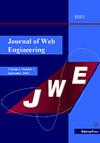A Memory Driven Self-learning Combat Agent Architecture in a 3D Virtual Environment
IF 1
4区 计算机科学
Q4 COMPUTER SCIENCE, SOFTWARE ENGINEERING
引用次数: 0
Abstract
Agent behavior modeling in 3D virtual environments is a critical challenge in artificial intelligence and military simulation. While rule-based methods (e.g., finite state machines) are widely used, their limitations in adaptability and development efficiency hinder their application in dynamic combat scenarios. To address this, a memory-driven self-learning agent (MDSLA) architecture is proposed, integrating visual, auditory, and game features to simulate human-like battlefield decision-making. The architecture employs an asynchronous advantage actor-critic (A3C) framework to enhance training efficiency and incorporates a memory module for processing historical perception data. Experimental validation in the Vizdoom environment demonstrates that MDSLA outperforms traditional rule-based methods and mainstream reinforcement learning algorithms in convergence speed and combat effectiveness. Furthermore, a parallel simulation mechanism is implemented via high-speed middleware, enabling seamless deployment of the model on both Vizdoom and a high-precision simulation platform (HPSP). Results from HPSP experiments show a 33% reduction in task execution time and a 24.1% improvement in lethality compared to finite state machine-driven agents. This work provides a scalable framework for developing intelligent combat agents with enhanced adaptability and realism in 3D virtual environments.三维虚拟环境中记忆驱动的自学习战斗代理体系结构
三维虚拟环境中的智能体行为建模是人工智能和军事仿真领域的一个重要课题。虽然基于规则的方法(如有限状态机)被广泛应用,但其在适应性和开发效率方面的局限性阻碍了其在动态战斗场景中的应用。为了解决这个问题,提出了一种记忆驱动的自学习代理(MDSLA)架构,集成了视觉、听觉和游戏功能来模拟类似人类的战场决策。该体系结构采用异步优势参与者-评论家(A3C)框架来提高训练效率,并结合记忆模块来处理历史感知数据。在Vizdoom环境下的实验验证表明,MDSLA在收敛速度和战斗力方面优于传统的基于规则的方法和主流强化学习算法。此外,通过高速中间件实现并行仿真机制,使模型能够在Vizdoom和高精度仿真平台(HPSP)上无缝部署。HPSP实验的结果表明,与有限状态机驱动的代理相比,任务执行时间减少了33%,致死率提高了24.1%。这项工作为在三维虚拟环境中开发具有增强适应性和真实感的智能战斗代理提供了一个可扩展的框架。
本文章由计算机程序翻译,如有差异,请以英文原文为准。
求助全文
约1分钟内获得全文
求助全文
来源期刊

Journal of Web Engineering
工程技术-计算机:理论方法
CiteScore
1.80
自引率
12.50%
发文量
62
审稿时长
9 months
期刊介绍:
The World Wide Web and its associated technologies have become a major implementation and delivery platform for a large variety of applications, ranging from simple institutional information Web sites to sophisticated supply-chain management systems, financial applications, e-government, distance learning, and entertainment, among others. Such applications, in addition to their intrinsic functionality, also exhibit the more complex behavior of distributed applications.
 求助内容:
求助内容: 应助结果提醒方式:
应助结果提醒方式:


